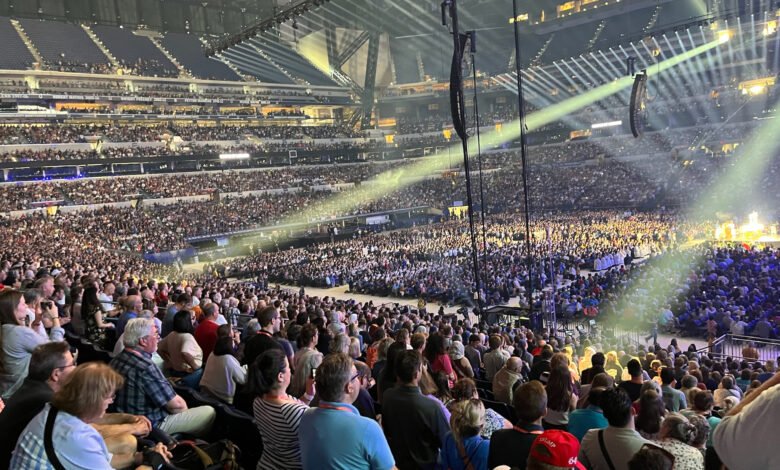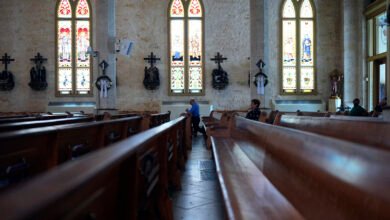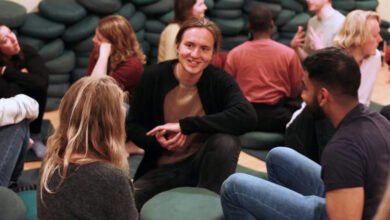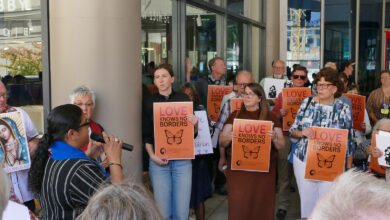
INDIANAPOLIS (RNS) — Aside from the screeches and hushed giggles of small children, the crowd in the Indianapolis Colts’ football stadium was silent.
Catholics, some quietly weeping, knelt on the hard, cold stadium concrete as spotlights lit a gold monstrance, the ornate vessel for displaying the Eucharist, on an altar in the center of the stadium.
The faithful gathered in Indianapolis on Wednesday night (July 17) had traveled from all 50 U.S. states and 17 countries to join the 10th National Eucharistic Congress, the first since the ninth National Eucharistic Congress in 1941. This Congress, running July 17-21, also serves as the kickoff for the third year of the U.S. Catholic bishops’ evangelization campaign, which has been holding events all across the U.S.
“Lord, we’ve come here to Indianapolis because we want to be changed,” Crookston, Minnesota, Bishop Andrew Cozzens prayed, after a Latin hymn broke the silence.
“We ask that through us a spirit of unity and peace would reign in our country,” the bishop prayed. “Lord, we pray for our church. Please grant us the unity you prayed for the night before you died,” he continued.
In his keynote, Cardinal Christophe Pierre, Pope Francis’ apostolic nuncio, or diplomatic representative, to the U.S., echoed those concerns, saying, “Perhaps our main prayer for this Eucharistic Congress should be this, that we, as a church, may grow in our unity so that we become more fruitful in our mission.”

Attendees of the National Eucharistic Congress in Indianapolis, July 17, 2024. (Photo by Casey Johnson, in partnership with the National Eucharistic Congress)
Before the Congress, as the National Eucharistic Revival ramped up, the ideological divisions in the church were especially evident, as some theology professors and a few bishops publicly criticized the financial cost of the Congress and its emphasis on personal devotion, rather than a more service oriented church.
Many critics suggested the Congress, which aside from Pierre features few cardinals created by Pope Francis, ran counter to the pope’s emphasis with the Synod on Synodality, a global Catholic listening project that at one point asked Catholics to “enlarge the space of your tent.”
But between versions of worship songs from evangelical groups such as Elevation Worship and Bethel Music, Cozzens and Pierre cited Francis multiple times.
Cozzens relayed what Francis had said when he blessed the monstrance for the Congress: ”We become credible witnesses to the joy and transforming beauty of the gospel only when we recognize the love that we celebrate in this sacrament cannot be kept to ourselves.”

First night of revival during the National Eucharistic Congress in Indianapolis, July 17, 2024. (Photo by Casey Johnson, in partnership with the National Eucharistic Congress)
John Gutzweiler, an attendee and secular Carmelite from Whitestown, Indiana, told Religion News Service he didn’t see any conflict between his Make America Great Again ball cap and Pierre’s call for unity.
“This is pro-Catholic,” Gutzweiler said about the hat bearing presidential nominee Donald Trump’s famous slogan, while on stage the emcees introduced Sister Bethany Madonna. The Sister of Life spoke about her struggles to maintain her vocation to anti-abortion ministry amd described serving in a pregnancy crisis center and working with women after abortion.
“The enemy is an accuser and a liar, and shame and blame are his signatures,” Madonna said after recounting the ways she believed the devil had tried to dissuade her from following her vocation, and telling a story of a woman who had abortions feeling reluctant to attend confession.
The next day, as Congress attendees tried to move through packed halls between events in the Indiana Convention Center, the pace sometimes slowed to a crawl as groups navigated in different directions without any clear traffic pattern.
Beyond many religious in habits, some Congress attendees wore shirts from their parish, and others wore T-shirts with phrases such as “Single, Catholic Pro-life Man,” “Pray the rosary, kill your demons,” “It’s cool to be kind” and “God is good.”

First night of revival during the National Eucharistic Congress at Lucas Oil Stadium in Indianapolis, July 17, 2024. (RNS photo/Aleja Hertzler-McCain)
At a Thursday news conference, Cozzens told reporters he’d been saying to people, “This is a pilgrimage and not a vacation,” as he acknowledged he had been running late to the news conference because Communion had taken longer than expected at the preceding Mass.
”This is what we expect on pilgrimage. There’s going to be long lines. It can take a while to get to Communion,” Cozzens said.
On Wednesday, organizers had to waive the requirement for Congress credentials to enter the stadium because the check-in line wrapped around multiple city blocks less than an hour before the Congress was scheduled to begin.
As the Vatican works toward net zero emissions, it has incorporated environmental stewardship into major events, like the Synod on Synodality. One of Francis’ three major teaching documents, or encyclicals, focuses on the environment. At the Synod, the Vatican incorporated the 2015 encyclical, “Laudato Si’,” by pursuing carbon offsets in a project that introduces efficient cook stoves and water purification technology in Nigeria and Kenya.
When asked at Thursday’s news conference whether the Congress’ logistics or programming had been impacted by “Laudato Si’,” Tim Glemkowski, the CEO of the Congress, said, “As much as possible, as much as we can, we’re always trying to be attentive” to those concerns. Glemkowski also cited “real sensibility” around “green solutions” in Indianapolis.

John Barker at the National Eucharistic Congress in Indianapolis, July 18, 2024. (RNS photo/Aleja Hertzler-McCain)
For Franciscan John Barker, resting against the wall of the convention center, the crowds pushing by were an encouragement. “It’s easy sometimes to feel like nobody is listening, that everyone in the church is sort of withering away,” he said, but coming to the Congress and seeing so many people and religious, “that gives me a lot of hope and strength,” in addition to what he gets from the Lord, he added.
Even so, Barker said that “struggles and diminishment” aren’t “necessarily negative things” in a church that started out small and that believes in the Parable of the Mustard Seed, where a small seed grows into a large tree.
As a transitional deacon who will become a priest next month at Holy Family parish in Oldenburg, Indiana, Barker said the Congress is “supporting” and “strengthening” his “strong desire to evangelize.”
In one of several Thursday morning sessions, Brownsville, Texas, Bishop Daniel Flores told Spanish-speaking Congress attendees that the church’s riches come from its poverty.
“The Lord asks us to be accessible to the most vulnerable,” Flores said, later criticizing those who blame poor people for their poverty and urging his listeners to imitate Christ’s style of humility, poverty and accessibility.
Sister Lourdes Melendez, a Franciscan Missionary Sister of the Immaculate Conception who was attending the Congress with the Diocese of Green Bay, Wisconsin, told RNS in Spanish that her community works with low-income people, as well as migrants in Tijuana.
Melendez called the Congress “a very marvelous encounter with our Lord,” explaining that, while it can be hard to have that encounter in simple things, she saw him through the silence in the stadium and through the poor.
Soila Noguez came to the Congress from Houston with her daughter, saying she hoped her daughter’s faith would grow and they both would find healing, peace and tranquility.

Colette St. Cloud at the National Eucharistic Congress in Indianapolis, July 18, 2024. (RNS photo/Aleja Hertzler-McCain)
“Sometimes I see in my church that sometimes Catholics themselves form little groups, and we separate, and I think we should be more united,” Noguez told RNS in Spanish. “Here, everyone from the whole nation is coming.”
Colette St. Cloud, who hails from Georgia and does religious education for children, said a major challenge to unity in the church is a failure to make space for the younger generation. When she works with kids, she emphasizes God’s love, acceptance and closeness.
St. Cloud, whose husband is becoming a deacon, said, “What we need to do as Catholics is a little less judging and a little bit more loving.“
Source link




